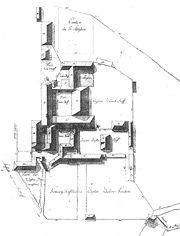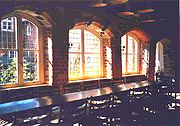
Lüne Abbey
Encyclopedia

Abbey
An abbey is a Catholic monastery or convent, under the authority of an Abbot or an Abbess, who serves as the spiritual father or mother of the community.The term can also refer to an establishment which has long ceased to function as an abbey,...
in Lüneburg
Lüneburg
Lüneburg is a town in the German state of Lower Saxony. It is located about southeast of fellow Hanseatic city Hamburg. It is part of the Hamburg Metropolitan Region, and one of Hamburg's inner suburbs...
, in the German state of Lower Saxony
Lower Saxony
Lower Saxony is a German state situated in north-western Germany and is second in area and fourth in population among the sixteen states of Germany...
, which was originally built for Benedictine
Benedictine
Benedictine refers to the spirituality and consecrated life in accordance with the Rule of St Benedict, written by Benedict of Nursia in the sixth century for the cenobitic communities he founded in central Italy. The most notable of these is Monte Cassino, the first monastery founded by Benedict...
nuns and today is home to a chapter of Lutheran nuns. It is one of several monasteries administered by the Hanoverian monastic chamber (Klosterkammer Hannover).
History

Canonesses
A canoness is a member of a religious community of women living a simple life. Many communities observe the monastic rule of Saint Augustine. The name corresponds to the male equivalent, a canon. The origin and rules are common to both...
. Not until 1272 was the nunnery described in a document as an abbey for Benedictine nuns and only from the mid-14th century is a full adoption of Benedictine observances recorded.
The abbey was overseen by an abbess. Its administration and pastoral care was placed in the charge of a provost
Provost (religion)
A provost is a senior official in a number of Christian churches.-Historical Development:The word praepositus was originally applied to any ecclesiastical ruler or dignitary...
elected by the nuns. One of these provosts, Henry of Langlingen (aka of Langeln, d. 1381), was elected Prince-Bishop of Verden by the Verden cathedral chapter
Cathedral chapter
In accordance with canon law, a cathedral chapter is a college of clerics formed to advise a bishop and, in the case of a vacancy of the episcopal see in some countries, to govern the diocese in his stead. These councils are made up of canons and dignitaries; in the Roman Catholic church their...
in 1367. Lüne nunnery belonged to the Bursfelde Congregation
Bursfelde Congregation
The Bursfelde Congregation, also called Bursfelde Union, was a union of predominantly west and central German Benedictine monasteries and nunneries working for the reform of Benedictine practice. It was named after Bursfelde Abbey.-Background:...
.
Following the introduction of the Reformation
Protestant Reformation
The Protestant Reformation was a 16th-century split within Western Christianity initiated by Martin Luther, John Calvin and other early Protestants. The efforts of the self-described "reformers", who objected to the doctrines, rituals and ecclesiastical structure of the Roman Catholic Church, led...
in the Principality of Lüneburg
Principality of Lüneburg
The Principality of Lüneburg was a territorial division of the Duchy of Brunswick-Lüneburg within the Holy Roman Empire, immediately subordinate to the emperor. It existed from 1269 until 1705 and its territory lay within the modern-day state of Lower Saxony in Germany...
the first service in the German language was celebrated on 26 April 1528 at the instigation of Duke Ernest the Confessor
Ernest I, Duke of Brunswick-Lüneburg
Ernest of Brunswick-Lüneburg , also frequently called Ernest the Confessor, was duke of Brunswick-Lüneburg and a champion of the protestant cause during the early years of the Protestant Reformation...
, despite the opposition of the nuns. In 1529 the provostship's property was placed under ducal administration and a new provost, selected by the local lords, was installed who was to ensure the implementation of Lutheran
Martin Luther
Martin Luther was a German priest, professor of theology and iconic figure of the Protestant Reformation. He strongly disputed the claim that freedom from God's punishment for sin could be purchased with money. He confronted indulgence salesman Johann Tetzel with his Ninety-Five Theses in 1517...
doctrine.
However, due to considerably resistance by the orthodox nuns it took until 1562 before the new doctrine was fully adopted throughout the convent. On the basis of a rule in the Lüneburg Monastic Regulations the monastery retained its independence however.
In 1711, at the behest of Duke George-Louis
George I of Great Britain
George I was King of Great Britain and Ireland from 1 August 1714 until his death, and ruler of the Duchy and Electorate of Brunswick-Lüneburg in the Holy Roman Empire from 1698....
(later George I of Great Britain) the monastery was turned into a Lutheran convent, whose primary task was to take care of unmarried daughters of Lüneburg's country gentry.
The nunnery has belonged to the Hanoverian monastic chamber since the 19th century. Currently (2008) it is in the charge of Abbess Reinhild von der Goltz.
Architecture


Brick Gothic
Brick Gothic is a specific style of Gothic architecture common in Northern Europe, especially in Northern Germany and the regions around the Baltic Sea that do not have natural rock resources. The buildings are essentially built from bricks...
style after a major fire. The cloisters, the single-nave church of 1412 and the Nonnenchor are well preserved, the same is true of the former Dormitorium (dormitory).
Art
Lüne is famous for its knitting and embroidery (wool on linen). Valuable pieces (white embroidery (Weißstickerei) altar cloths, fasting cloths (Fastentücher) and carpets, the oldest dating to around 1250, are displayed in the textile museum in the grounds of the monastery opened in 1995. In the church on the altar in the Nonnenchor is a painting from the workshop of Lucas Cranach the ElderLucas Cranach the Elder
Lucas Cranach the Elder , was a German Renaissance painter and printmaker in woodcut and engraving...
. The high altar's triptych
Triptych
A triptych , from tri-= "three" + ptysso= "to fold") is a work of art which is divided into three sections, or three carved panels which are hinged together and can be folded shut or displayed open. It is therefore a type of polyptych, the term for all multi-panel works...
(carved altar) was made in the early 16th century. Also worthy of mention are the wall paintings from around 1500 in the refectory
Refectory
A refectory is a dining room, especially in monasteries, boarding schools and academic institutions. One of the places the term is most often used today is in graduate seminaries...
of the monastery.
Literature
Angela Lorenz-Leber: Kloster Lüne. Aufnahmen von Jutta Brüdern. Königstein i. Ts. 1991 (= Die Blauen Bücher), ISBN 3-7845-0828-6External links
- http://www.kloster-luene.de

